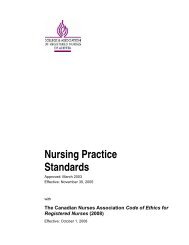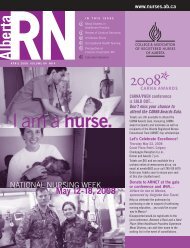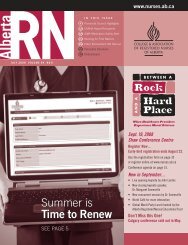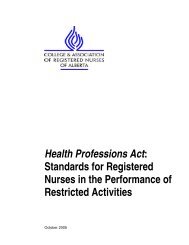Infection Prevention and Control Best Practices - College ...
Infection Prevention and Control Best Practices - College ...
Infection Prevention and Control Best Practices - College ...
Create successful ePaper yourself
Turn your PDF publications into a flip-book with our unique Google optimized e-Paper software.
INFECTION PREVENTION AND CONTROL BEST PRACTICES<br />
FOR LONG TERM CARE AND COMMUNITY CARE INCLUDING HEALTH CARE OFFICES AND AMBULATORY CLINICS<br />
APPENDIX I<br />
DEFINITIONS<br />
ARO – ANTIBIOTIC RESISTANT ORGANISMS<br />
An individual form of life (i.e. bacteria) that can withst<strong>and</strong> the effects of an antibiotic.<br />
BACTERIA<br />
Any of the unicellular, prokaryotic microorganisms of the class Schizomycetes, which vary in terms of morphology,<br />
oxygen <strong>and</strong> nutritional requirements, <strong>and</strong> motility, <strong>and</strong> may be free-living, saprophytic, or pathogenic, the<br />
latter causing disease in plants or animals.<br />
COLONIZED<br />
When a person has bacteria living on their skin or in their throat but is not ill because of it.<br />
COMPETENCY<br />
The individual should demonstrate proficient application of the skills <strong>and</strong> knowledge required to function capably,<br />
effectively <strong>and</strong> safely.<br />
Having the capacity to behave or work in a way that promotes a safe environment under usual circumstances by<br />
demonstrating knowledge <strong>and</strong> skills related to hygiene <strong>and</strong> asepsis.***<br />
***This process must be auditted on a routine basis to verify st<strong>and</strong>ards have been met.<br />
FUNGUS<br />
Any of numerous eukaryotic organisms that reproduce by spores. The spores of most fungi grow a network of<br />
slender tubes called hyphae that spread into <strong>and</strong> feed off of dead organic matter or living organisms. The<br />
hyphae often produce specialized reproductive bodies, such as mushrooms.<br />
HEALTH CARE WORKER<br />
Individual providing or supporting health care services that will bring them into contact with patients/clients/<br />
residents.<br />
This includes, but is not limited to:<br />
� Emergency service workers, physicians, dentists, chiropractors, nurses, podiatrists, respiratory therapists <strong>and</strong><br />
other allied health professionals, students, support services (e.g. housekeeping, dietary, maintenance,<br />
hairdressers), <strong>and</strong> volunteers<br />
HIERARCHY OF CONTROL MEASURES<br />
(Adapted from BC Centre for Disease <strong>Control</strong> Document on Respiratory Outbreaks)<br />
There are important concepts regarding infection prevention <strong>and</strong> control measures that have been clarified<br />
over the past decade. Working with occupational health <strong>and</strong> safety groups <strong>and</strong> building engineers has created<br />
a framework that includes three levels of control: engineering controls, administrative controls <strong>and</strong> personal<br />
protective measures.<br />
1. Engineering controls are built into the design (private bathrooms, private rooms, HVAC systems) of a health<br />
care facility. <strong>Infection</strong> prevention <strong>and</strong> control professionals should be involved in the design <strong>and</strong> planning<br />
of new facilities. An <strong>Infection</strong> <strong>Control</strong> Risk assessment should be done to evaluate <strong>and</strong> mitigate potential<br />
risks for microorganism transmission by means of air, water <strong>and</strong> environmental sources.<br />
2. Administrative controls include protocols for h<strong>and</strong> hygiene, immunization of residents <strong>and</strong> caregivers,<br />
protocols for managing caregivers <strong>and</strong> clients during an outbreak <strong>and</strong> protocols for caring for clients with<br />
communicable diseases.<br />
3. Personal protective equipment is the least desirable way to control hazards as it does not eliminate them, it<br />
merely contains the hazard <strong>and</strong> is dependent on its appropriate use by educated, knowledgeable staff.<br />
Canadian Committee on Antibiotic Resistance<br />
[24]







